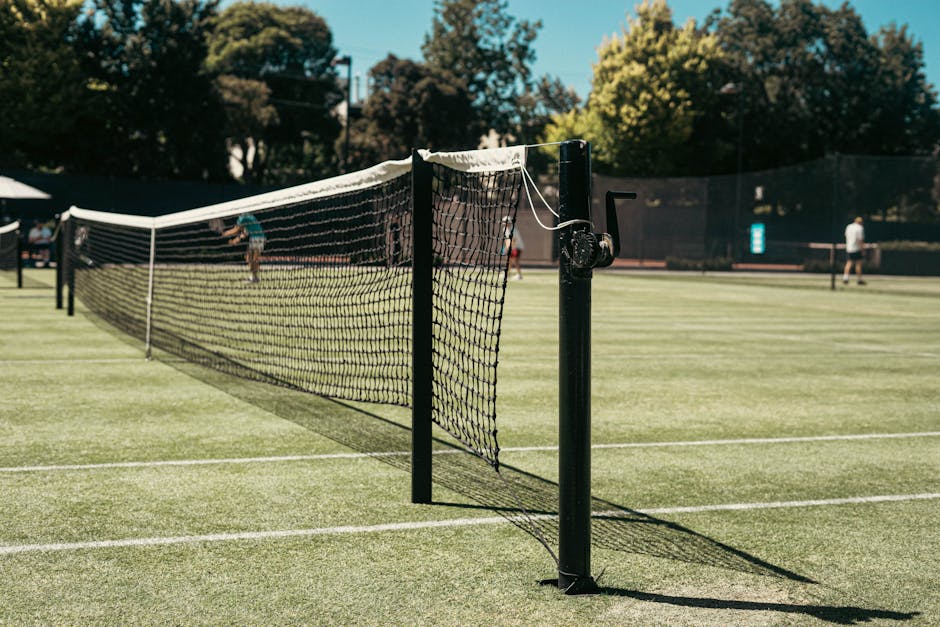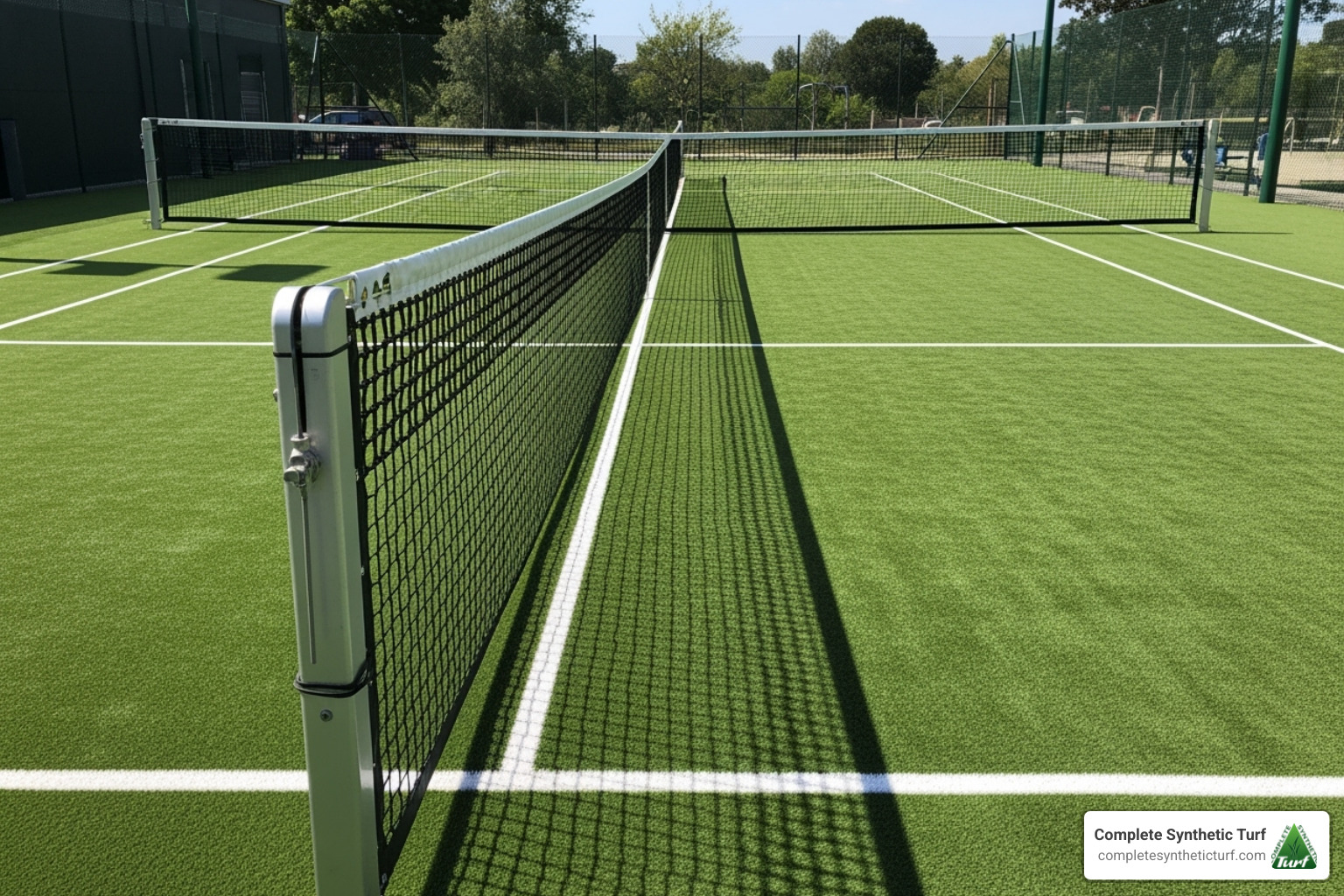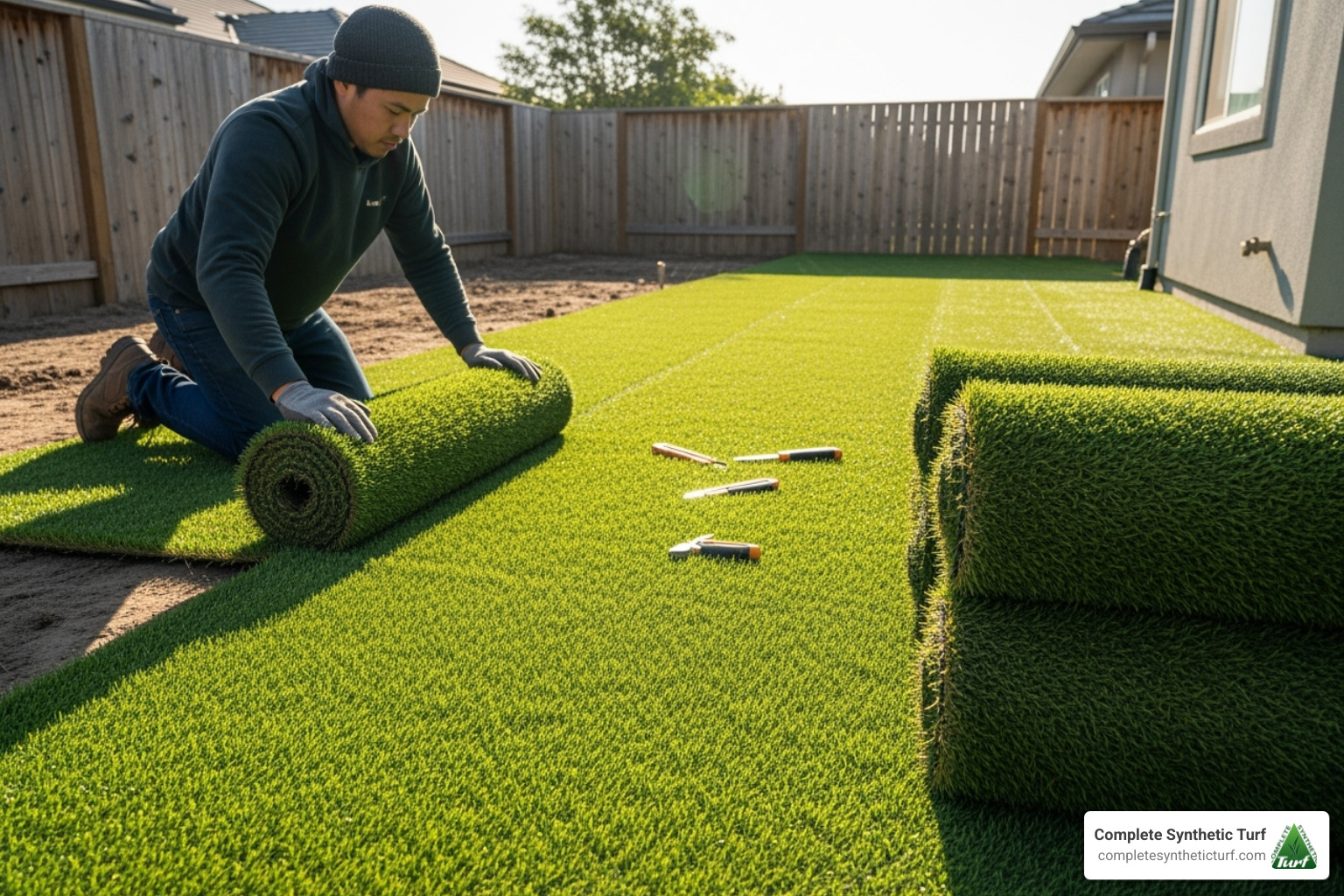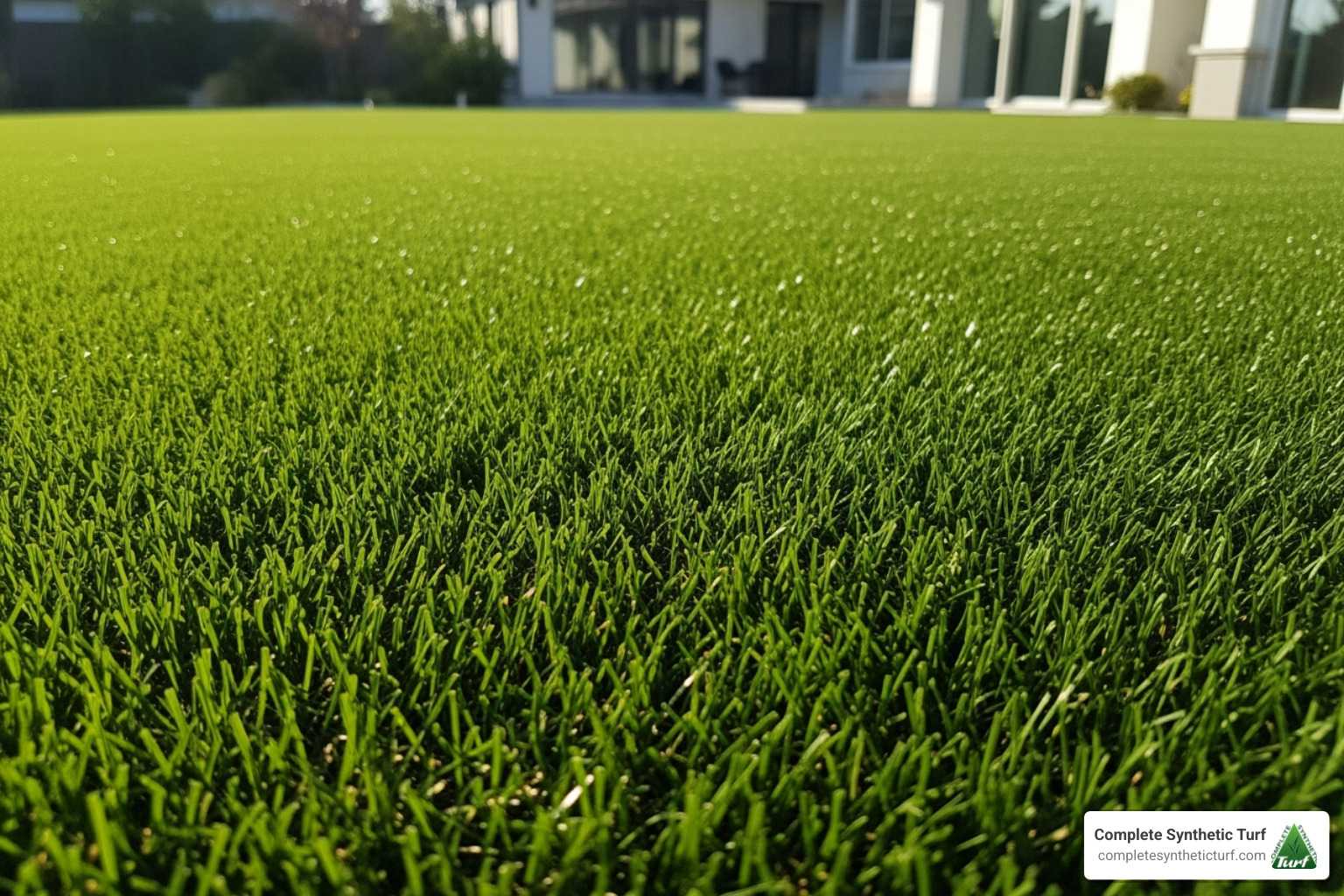Synthetic Grass Tennis Court: Top 5 Cost-Saving Benefits
Synthetic grass tennis court solutions have come a long way, changing the landscape of tennis from its traditional roots to modern innovation. Historically, grass courts were synonymous with elegance and prestige, as seen at the iconic Wimbledon championships. However, the demands of maintaining natural grass courts, especially outside the English climate, proved challenging.
Today, synthetic grass offers a sustainable, low-maintenance alternative. With improved durability and performance, synthetic grass tennis courts offer the classic feel of grass with the practicality required for modern living.
- The Basics:
- Maintenance: Minimal compared to natural grass.
- Durability: Long-lasting, can withstand harsh weather.
- Performance: Provides a consistent playing surface year-round.
Transitioning from lawn to court, synthetic grass is revolutionizing the way tennis is enjoyed worldwide.

Benefits of Synthetic Grass Tennis Courts
When it comes to tennis courts, synthetic grass offers a range of benefits that make it an attractive option for both home use and professional facilities. Let’s break down why synthetic grass is gaining popularity in tennis.
Low Maintenance
One of the biggest advantages of synthetic grass tennis courts is their low maintenance. Unlike natural grass courts, which require regular mowing, watering, and fertilizing, synthetic grass needs minimal upkeep. Just a quick clean and occasional brushing to keep the fibers standing tall is usually enough. This saves time and money, allowing players to focus more on their game and less on court care.
Consistent Surface
A consistent playing surface is crucial for a fair and enjoyable game. Synthetic grass delivers just that. It provides a uniform ball bounce and predictable play, which is essential for players to develop and hone their skills. This consistency is maintained throughout the year, regardless of weather conditions.
Weather Resistance
Synthetic grass courts are designed to withstand various weather conditions, making them ideal for regions with unpredictable climates, like South Florida. Whether it’s raining or sunny, these courts remain playable and safe, ensuring that your tennis plans aren’t disrupted by the weather.
Safety
Safety is a top priority for any sports surface. Synthetic grass offers good traction to prevent slips and falls. It’s also softer on joints compared to harder surfaces like concrete, reducing the risk of injuries. This makes it a great choice for players of all ages, including young children and older adults.

Aesthetics
Finally, let’s talk about aesthetics. Synthetic grass tennis courts maintain their lush, green appearance all year round, without the brown patches or muddy areas that can plague natural grass courts. They look pristine and inviting, adding to the overall appeal of any property. Whether you prefer the classic green or want to mimic the look of clay courts, there are color options to suit your taste.
In summary, synthetic grass tennis courts provide a perfect blend of practicality and beauty, making them a smart choice for anyone looking to enjoy tennis without the hassle of high maintenance.
Leading into the next section, let’s explore how these courts are installed and the considerations involved in setting up your own synthetic grass tennis court.
Installation Process of Synthetic Grass Tennis Courts
Installing a synthetic grass tennis court involves several key steps to ensure a high-quality playing surface that lasts. Let’s walk through the process, from initial preparation to the final touches.
Preparation
Before installation begins, thorough preparation is crucial. This starts with a topographic and feasibility survey to assess the site. The ground must be leveled and compacted to create a stable base. Any existing vegetation or debris is cleared, and the area is graded to ensure proper drainage. This step is vital because it prevents water from pooling on the court, which could affect playability.
Installation Steps
Once the site is ready, the installation process can begin:
-
Base Construction: A solid base is laid down, often using materials like crushed stone. This base needs to be well-compacted and level to support the synthetic turf.
-
Drainage System: Proper drainage is integrated into the base. This is essential for keeping the court dry and playable even after heavy rain. Drainage pipes and channels are strategically placed to direct water away from the court.
-
Turf Installation: The synthetic grass is rolled out over the prepared base. It’s carefully positioned and cut to fit the court dimensions. Seams are joined using adhesive to ensure a smooth, continuous surface.
-
Infill Application: A layer of infill, often sand or rubber granules, is spread across the turf. This helps keep the grass fibers upright and provides additional cushioning.
-
Final Grooming: The surface is brushed to distribute the infill evenly and to give the grass a natural, upright appearance.
Base Options
The base of a synthetic grass tennis court can vary depending on the desired playing characteristics and site conditions. Common base options include:
- Crushed Stone: Offers excellent drainage and stability.
- Asphalt or Concrete: Provides a firm, durable foundation but may require additional cushioning layers for comfort.
- Permeable Concrete: Combines strength with good drainage properties.
Drainage
Effective drainage is a critical component of a successful synthetic grass tennis court. It ensures that the court remains playable in all weather conditions. A well-designed drainage system will quickly channel water away, preventing puddles and maintaining the court’s integrity.
In summary, the installation of a synthetic grass tennis court is a meticulous process that involves careful planning and execution. By considering factors like base options and drainage, you can ensure a court that offers excellent performance and longevity.
Next, we’ll dig into how these courts perform in terms of ball bounce, foot sliding, and overall playability.
Synthetic Grass Tennis Court Performance
When it comes to synthetic grass tennis courts, performance is key. Players expect a court that provides a consistent and enjoyable experience. Let’s explore how these courts measure up in terms of ball bounce, foot sliding, playability, and durability.
Ball Bounce
One of the standout features of synthetic grass is its ability to deliver a predictable ball bounce. Unlike natural grass, which can vary day-to-day depending on weather and wear, synthetic surfaces provide a uniform bounce every time. This consistency is crucial for players to develop and maintain their skills, as they can rely on the ball behaving the same way with each game.
Foot Sliding
Synthetic grass courts are designed to mimic the sliding sensation found on natural grass or clay courts. This slight foot sliding is beneficial as it reduces the risk of “foot lock,” which can occur on harder surfaces like concrete. By allowing players to slide slightly when stopping or pivoting, synthetic grass helps reduce strain on joints and muscles, offering a more comfortable playing experience.
Playability
These courts shine in terms of playability. Synthetic grass provides a surface that is both firm and elastic, ensuring that players can enjoy a game similar to those on traditional hard courts, but with added cushioning. This balance makes them suitable for various playing styles, from aggressive serve-and-volley to baseline rallies. The surface’s adaptability also means that it can be used for other sports, such as hockey and cricket, adding to its versatility.
Durability
Durability is a significant advantage of synthetic grass tennis courts. Made from high-quality yarns and materials, these courts are built to withstand regular play over many years. With proper maintenance, they remain in excellent condition, resisting wear and tear better than natural grass. Additionally, their excellent drainage properties mean they can be used soon after rain, unlike natural grass which might become waterlogged.

In summary, synthetic grass tennis courts offer a blend of consistent performance, reduced maintenance, and improved player comfort. These features make them an attractive option for both casual players and serious athletes.
Next, let’s explore the cost considerations associated with installing and maintaining synthetic grass tennis courts.
Cost Considerations for Synthetic Grass Tennis Courts
When thinking about investing in a synthetic grass tennis court, understanding the costs is crucial. Let’s break down the key financial aspects: installation cost, maintenance savings, and the long-term investment potential.
Installation Cost
The initial cost of installing a synthetic grass tennis court can vary depending on several factors. These include the size of the court, the quality of the materials used, and any additional features like lighting or fencing. On average, you might expect to pay anywhere from $50,000 to $100,000 for a standard court. While this might seem like a significant investment upfront, it’s important to consider the long-term benefits.
Maintenance Savings
One of the biggest advantages of synthetic grass is the reduction in maintenance costs. Unlike natural grass, which requires regular mowing, watering, and fertilizing, synthetic surfaces are low maintenance. You won’t need to worry about irrigation systems or hiring a groundskeeper. Basic upkeep involves occasional sweeping and checking for debris. This can lead to substantial savings over time, as you eliminate the recurring expenses associated with maintaining a natural grass court.
Long-Term Investment
Investing in a synthetic grass tennis court is not just about the immediate cost—it’s about the long-term benefits. These courts are built to last, providing a durable playing surface for many years. With proper care, they maintain their appearance and functionality, potentially increasing the value of your property. Moreover, the consistent playability and low maintenance make them an attractive feature for potential buyers if you ever decide to sell your home.
In conclusion, while the initial installation cost of a synthetic grass tennis court might be higher than other options, the maintenance savings and long-term durability make it a wise investment. For more information on the costs and benefits of synthetic grass tennis courts, visit Complete Synthetic Turf.
Frequently Asked Questions about Synthetic Grass Tennis Courts
Can you play tennis on artificial grass?
Absolutely! A synthetic grass tennis court offers a consistent surface and predictable bounce, making it ideal for tennis. Unlike natural grass, which can become uneven or muddy, synthetic grass stays uniform and ready for play in various weather conditions. This consistency improves your game, allowing players to focus on strategy rather than worrying about the court condition.
How much does a turf tennis court cost?
The cost of a synthetic grass tennis court can vary based on several factors. Generally, prices range from $50,000 to $100,000. Variables that affect the price include the size of the court, the quality of materials, and any additional features like lighting or fencing. While this might seem like a hefty price tag, consider the long-term savings on maintenance and the durability of the surface. Over time, these benefits can offset the initial investment.
Is a synthetic tennis court good?
Yes, a synthetic tennis court is an excellent choice for many reasons. It offers affordability in terms of maintenance, as there’s no need for mowing, watering, or fertilizing. Safety is another key benefit; the surface absorbs impact, reducing strain on joints. Playability is improved with a consistent surface that provides reliable ball bounce and foot sliding, similar to natural grass or clay courts. These features make synthetic courts a practical and enjoyable option for tennis enthusiasts.
Conclusion
Choosing a synthetic grass tennis court is a smart investment for anyone looking to enjoy tennis year-round without the hassle of maintaining a natural grass court. At Complete Synthetic Turf, we bring over 60 years of expertise to every project, ensuring that your court is not just functional but also improves the beauty of your property.
Our team is dedicated to serving Florida, from the Treasure Coast to the Space Coast, and even extending our services to the Caribbean. Whether you’re in West Palm Beach, Jupiter, Boca Raton, or Vero Beach, we’ve got you covered. Our knowledgeable professionals handle everything from design to installation, making the process smooth and stress-free for you.
We pride ourselves on exceptional customer support. Whether you have questions about installation, maintenance, or costs, you can count on us to provide clear, honest answers. Feel free to call or visit our headquarters in Stuart, FL, where we’re always ready to assist you.
With Complete Synthetic Turf, you’re not just getting a tennis court; you’re making a long-term investment in quality and performance. Experience the benefits of a synthetic grass court and enjoy the game you love, any time of the year. Ready to transform your space? Contact us today to get started on your dream tennis court.




